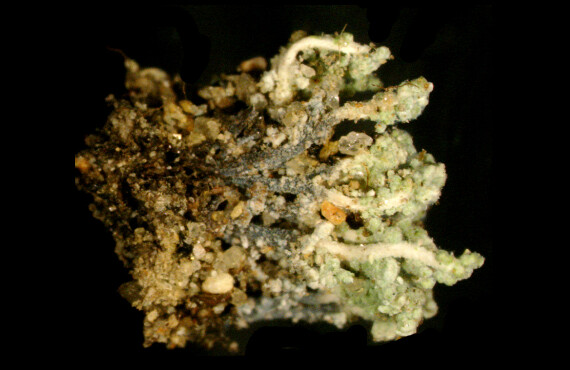Penn Researcher’s Studies Yield Surprises About Lichens, Biodiversity
Since the time of Linnaeus and even before, biologists and naturalists have been keen to organize living things into distinct groups. Now the modern technology of rapid DNA sequencing has revolutionized that categorizing task, providing a window into the relationships among species about which little was once known.
In three recent papers, University of Pennsylvania postdoctoral researcher Brendan Hodkinson and James Lendemer, a Penn alumnus and current postdoctoral researcher at the New York Botanical Garden, apply DNA sequencing and bioinformatics to shed light on lichen phylogeny, or the make-up of their “family trees.” These investigations not only generated massive amounts of new data, which the researchers and others can now ply for insights into lichen biology, but also demonstrate that — at least when it comes to lichens — species are not always what they seem.
Lichens are a union of at least two organisms, a fungus and a photosynthetic alga, living in symbiosis. For each lichen, the name of its “species” refers only to the fungal partner, as the fungus generally dominates the association and gives each lichen its basic structure. Hodkinson, of Penn’s Perelman School of Medicine Department of Dermatology, has long been interested in these organisms, studying them during both his undergraduate and graduate work.
Though lichens can be striking in color and form, most people do not consider them as traditionally comely as pandas or even oak trees. Yet they nevertheless hold the potential to improve human well being.
“Lichens produce copious amounts of secondary compounds, and a lot of them have been shown to have antibiotic properties,” Hodkinson said. “And there’s a whole world of chemical compounds that’s really hardly been explored.”
Since the majority of the work for these publications was conducted by the two researchers in a botanical setting, the New York Botanical Garden, Hodkinson’s current position as a researcher in a dermatology lab, where he studies the communities of microorganisms that live on skin, might seem incongruous with his earlier pursuits in lichenology. But to him the work has all the same essential elements.
“I’m really interested in using molecular biology and bioinformatics techniques to answer questions about ecology and evolution,” Hodkinson said. “That’s the unifying theme for me no matter what system I’m working in.”
Hodkinson’s explorations, together with Lendemer, have blended expertise in bioinformatics with an intimate knowledge of lichen phylogeny. Their unique take on lichen analysis began with an examination of an organism that is found throughout the Appalachian Mountains but which scientists had difficulty assigning to a specific genus. Further complicating matters, the lichen was sterile. Normally biologists rely in part on a lichen’s sexual characteristics — specifically its spores — to help classify the organism.
In this case, they turned to genomic sequencing, focusing on two regions of DNA, one that evolves quickly and one more slowly. The faster-evolving DNA segment helps the researchers place the organism on a genus and species level, while the slower-evolving sequence proves useful in sorting it at a higher-order level. They also used traditional taxonomic approaches to classifying the lichen, including chemical and physical analyses.
Their results, reported in the journal Systematic Botany, revealed that the old “best guess” of where this lichen fell, which had been based simply on its physical appearance, was misplaced.
“When we did the molecular work, it was clear that it was in this other genus, in a different family, in a different order,” Hodkinson said. “It’s an odd member of that group because it doesn’t look like most of the other members.”
The greenish-gray lichen, which Hodkinson and Lendemer dubbed Caloplaca reptans, turned out to be closely related to a group of lichens that are generally known for producing bright orange compounds.
With this unexpected reclassification in hand, the two researchers turned their attention to an undescribed species that a scientist at the New York Botanical Garden had found in a remote part of southern South America.
Applying similar methods as they had in the first study, the researchers found another case of mistaken identity. Their analysis placed this species, which Hodkinson and Lendemer named Chirleja buckii, in an entirely different grouping than they had originally anticipated. They reported their findings in the New Zealand Journal of Botany.
“It was in a group, a family and an order that are pretty well-characterized, but it was just this very odd representative,” Hodkinson said. “We realized that this was a new genus, in an order that was totally unrelated to what we would have thought it was.”
The final paper, published in Mycologia, involved the biggest shakeup to lichen taxonomy of the three. Again using similar techniques, Hodkinson and Lendemer analyzed a group of species that had been placed in the genus of sterile lichens called Lepraria.
“People had inferred that these lichens were all related because they’re all sterile,” Hodkinson said. “But when we collected molecular data on them, we realized that in order to work out the taxonomy we had to create a new order, a new family, a new genus and two new species.”
Though Hodkinson is hopeful that this new understanding of lichen taxonomy may lend new insights into compounds that might prove beneficial for humans, he emphasized that the work also has intrinsic value, as another step on the path toward categorizing and understanding life on Earth.
“To me, biodiversity is inherently interesting,” he said.
The studies were supported by the National Science Foundation, City University of New York, National Park Service, Southern Appalachian Botanical Society, Torrey Botanical Society, Western Pennsylvania Conservancy, New York Botanical Garden, California Lichen Society, Nature Conservancy and American Bryological and Lichenological Society.








